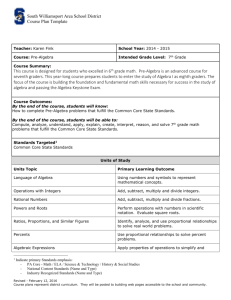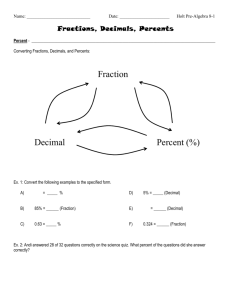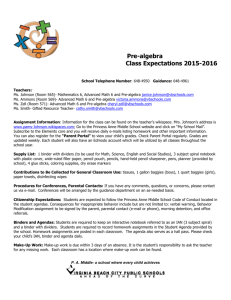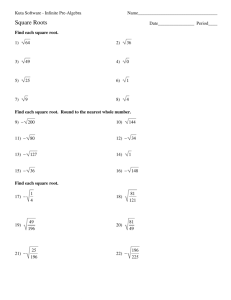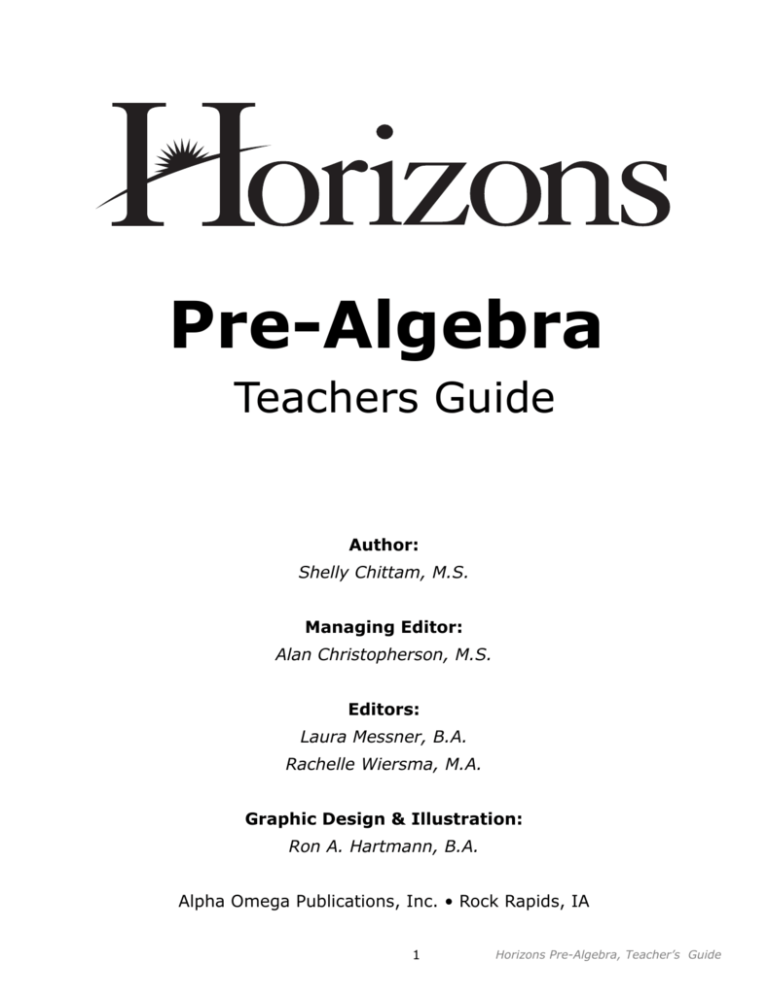
Pre-Algebra
Teachers Guide
Author:
Shelly Chittam, M.S.
Managing Editor:
Alan Christopherson, M.S.
Editors:
Laura Messner, B.A.
Rachelle Wiersma, M.A.
Graphic Design & Illustration:
Ron A. Hartmann, B.A.
Alpha Omega Publications, Inc. • Rock Rapids, IA
1
Horizons Pre-Algebra, Teacher’s Guide
©MMX by Alpha Omega Publications, Inc.®
804 N. 2nd Ave. E.
Rock Rapids, IA 51246-1759
All rights reserved.
No part of this publication may be reproduced, stored in an electronic retrieval system,
or transmitted in any form by any means—electronic, mechanical, photocopy, recording
or otherwise—without the prior written permission of Alpha Omega Publications, Inc.
Brief quotations may be used in literary review.
Printed in the United States of America
ISBN 978-0-7403-2243-3
All rights reserved.
Horizons Pre-Algebra, Teacher’s Guide
2
Pre-Algebra
Teachers Guide
Contents
Course Introduction ......................................................................................... 5
Readiness Evaluation ....................................................................................... 12
Preparing a Lesson .......................................................................................... 17
Scope & Sequence ........................................................................................... 21
Where to Use Mathematics Worksheets .............................................................. 25
Appearance of Concepts ................................................................................... 27
Teacher’s Lessons ............................................................................................ 38
3
Horizons Pre-Algebra, Teacher’s Guide
Horizons Pre-Algebra, Teacher’s Guide
4
Course Introduction
Purpose
This pre-algebra course has a two-fold purpose. First, students have a thorough review of
math concepts taught in elementary school that are vital for success in upper-level math
courses. These concepts include basic math operations with whole numbers, decimals,
fractions, percents, roots, and exponents. Emphasis is placed on practical application of the
concepts.
The second purpose of the course is to introduce the students to concepts of algebra,
trigonometry, and geometry in preparation for upper-level math courses. After completing this
course of study, students should be well prepared for a high school level course in Algebra I.
Materials
Materials available for this course include the Teacher’s Guide, the Student Book, and the
Tests and Resources Book. The students will have to supply notebook paper, as well as a
scientific calculator, colored pencils, a ruler, and graph paper. Often the Student Workbook
will not have sufficient space for working out all of the steps to the problems. Notebook paper
should be used for these situations. Graph paper should have no more than five squares per
inch, although quad-rule paper is recommended. The Student Workbook and the Tests and
Resources Book were designed to be consumables. Both have perforated pages for easy tear
out but it is recommended that the Student Workbook remain intact to serve as a resource
when students wish to review previously covered concepts.
5
Horizons Pre-Algebra, Teacher’s Guide
Layout
Each Lesson in the Student Text has a teaching box in the upper left side of the first page and
a Classwork section in the upper right side of the first page. The teaching box is intended
for use by both the teacher and the students as an aid to understanding the lesson. New
concepts are presented here in detail so students who miss a lesson in class should be able to
catch up any missed work with minimal outside help. The Classwork section is intended for the
class to do together, with individual students explaining the problems for the class.
Nets of Solid Figures
Lesson 97
1 CLASSWORK
A net !" # $!%&' ()*+, &$ # -.!/'&0,1$&!1#%
+,2+,$,1-#-&!1 !" # -3+,,/'&0,1$&!1#% ()*+,4 5is what a solid would look like if it were opened
#- -3, ,'),$ #1' 2%#6,' 7#- !1 # $*+"#6,4
Draw a net for a square pyramid.
For example, the net of a cube could look like
-3, ()*+, 8,%!.4
Teaching Box
Classwork
When cut out and folded on the lines to make a
$!%&'9 &- .!*%' %!!: %&:, -3, ()*+,$ 8,%!.4
Some other common nets are those of
octahedrons (8 faces), dodecahedrons (12
faces), and icosahedrons (20 faces).
ACTIVITIES
2 Draw a net for a cube that is different from the one pictured above.
Horizons Pre-Algebra, Student Book
Horizons Pre-Algebra, Teacher’s Guide
213
6
Layout continued:
Following the Classwork section is the Activities section. The first problem set in each
Activities section is for reinforcement of the concept taught in that lesson. The remaining
Activities sections are for review of previously taught concepts. The Activities sections are part
of the assignment for each lesson.
Density
Lesson 99
1 CLASSWORK
Density$!($%&'$,8*."%$*+$8,(($3'4$."!%$*+$
7*1.8'$,"$*/9'-%$&,(5$$:0*$*/9'-%($0!%&$%&'$
(,8'$#!8'"(!*"($-,"$&,7'$#!++'4'"%$0'!;&%($!+$
%&'!4$#'"(!%!'($,4'$#!++'4'"%5$$:&'$;4',%'4$%&'$
#'"(!%)<$%&'$;4',%'4$%&'$0'!;&%$*+$,"$*/9'-%$*+$
'=.,1$(!>'5
6*17'5
?!11$,$3!'-'$*+$(*1!#$-&,1A$(!"A$*4$2$*,%$
!"$3.4'$0,%'4$!+$,$B5J$8@$3!'-'$*+$-&,1A$
&,($,$8,(($*+$KLCG5J$A;M
m
v
:&'$+*48.1,$+*4$#'"(!%)$!( d = ,$0&'4'$d is
the density, m is the mass, and v$!($%&'$7*1.8'5
?&,%$!($%&'$#'"(!%)$*+$0,%'4$!+$@$A;$&,($,$
7*1.8'$*+$B5BB@$8@?
d =
m
v
d =
B5BB@$8@
@$A;
d = KBBB$A;N8@
:&!($!($%&'$#'"(!%)$*+$3.4'$0,%'4$,%$CD$E'1(!.($
F,/*.%$@GD$ ,&4'"&'!%H5$$:,3$0,%'4$&,($,$
(1!;&%1)$&!;&'4$#'"(!%)$%&,%$7,4!'($/)$1*-,%!*"5$$
:'83'4,%.4'$0!11$,1(*$,++'-%$%&'$#'"(!%)$*+$0,%'45$$
I,%'4!,1($0!%&$,$&!;&'4$#'"(!%)$0!11$(!"A$!"$0,%'4<$
,"#$8,%'4!,1($0!%&$,$1*0'4$#'"(!%)$0!11$2$*,%$!"$
0,%'45
Activities
ACTIVITIES
2
!"#$%&'$#'"(!%)$*+$',-&$(./(%,"-'$,"#$!#'"%!+)$!+$!%$0!11$2$*,%$!"$3.4'$0,%'45
Substance
Mass
Volume
Apples
128.2 kg
0.2 m3
Ice
1314.17 kg
1.43 m3
Solid soap
5526.9 kg
6.9 m3
Silver
839.2 kg
0.08 m3
Horizons Pre-Algebra, Student Book
Density
Float: Y/N
217
7
Horizons Pre-Algebra, Teacher’s Guide
Lesson Plans
Each Lesson Plan lists all concepts taught and reviewed for that individual lesson. The Learning
Objectives always relate to the new material taught in that lesson. Each Lesson Plan contains
Teaching Tips to aid the teacher in presenting the new material. As often as possible, new
material is introduced following a review of related, previously-taught material. The Lesson
Plans give detailed helps for the teacher, including sample problems, illustrations, and visual
aids. The solution keys for the student activities are also part of each lesson plan.
Lesson 33
Concepts
Learning Objectives
Materials Needed
Teaching Tips
Concepts
! Fraction-decimal equivalents
! Absolute value
! Divisibility tests
! Prime/Composite numbers
! Multiplying by powers of 10
! Dividing by powers of 10
! Real world math
Learning Objectives
The student will be able to:
! Use division to convert a fraction to
a decimal
! Write a decimal as a fraction
! Reduce fractions to simplest form
! Memorize common fraction-decimal
equivalents
Materials Needed
! Student Book, Lesson 33
! "#$%&'()*+,%'-$.!/$01%$#+0
! Worksheet 17
Solution
Keys
Teaching Tips
Ask students how many quarters
are in a dollar. (4) Ask students
what fraction of a dollar is one
quarter. ( 14 ) Ask students what
the value of a quarter is. ($0.25)
Repeat this procedure with 2
quarters ( 12 , $0.50), and 3
quarters ( 34 , $0.75).
Show students the relationship
between the fraction and decimal
representations in the above
examples.
Introduce the fraction-decimal
equivalents in the student book.
Students should memorize these
values. They are not expected to
memorize fractions that are not on
this list.
Horizons Pre-Algebra, Teacher’s Guide
Horizons Pre-Algebra, Teacher’s Guide
8
109
Lesson Plans continued:
Some Lesson Plans will include a Worksheet. These are found in the Tests and Resources Book.
Some Worksheets are for additional practice of a new concept while others are for review or
a quiz grade. The Lesson Plan will indicate which case applies for each Worksheet. Those
intended for additional practice will appear in the Assignments section at the end of the Lesson
Plan.
Worksheet 54
1 Identify each angle as acute, right, obtuse, or straight. Find the measure of the
complementary and supplementary angles, if applicable, for each given angle.
Worksheet
(In Tests &
Resources)
19°
136°
167°
180°
71°
2°
2 Use the diagram below to answer the questions.
Use the diagram below to answer
the questions.
A
F
G
D
C
E
H
J
B
AB
CD and GH
Horizons Pre-Algebra, Test Booklet
Worksheet
Solution
(In Teacher’s
Guide)
List each straight angle using three
letters.
JF
163
Teaching Tips, Cont.
Explain that it is not necessary
to prime factor the radicand, but
rather look for perfect squares that
are factors.
Have students express each of the
following numbers as the product
of a perfect square and another
factor: 12 = (4 × 3), 18 = (9 × 2),
20 = (4 × 5), 24 = (4 × 6).
Show students that the process for
!"#!$%&!'%()*+,%,(()%#-%)*+%-&.+%
&-% !"#!$%)*+%-/0&,+%,(()1%+23+4)%
the number of equal factors in the
radicand must equal the number in
the index. For example, the cube
root of a number must have the
same factor appearing three times
in the radicand. The 4th root of a
number must have the same factor
appearing 4 times in the radicand.
Encourage students to prime factor
the radicand if they are having
"#5 306)'% !"#!$%)*+%,(()7
Complete the Classwork exercises.
Have some students work the
problems on the board for the
class. All students should work the
problems in their books.
Assignment
! Complete Lesson 18, Activities 2-6.
76
9
Horizons Pre-Algebra, Teacher’s Guide
Horizons Pre-Algebra, Teacher’s Guide
Learning Styles
Students learn in different ways. Some students can master a concept by listening to
instructions or watching someone else do it while others are very “hand-on” and must
physically do something to learn a new concept. This book addresses the various learning
styles by using a lecture-demonstration method to teach new concepts and review old
concepts, and manipulatives are used where appropriate to aid in the understanding of new
concepts.
1
Algebra Tiles
Algebra tiles are located in the Tests and Resources Book.
Students should cut these out the first time the Lesson
Plan calls for them, and store them in a zip-top bag for
future use. These manipulatives will assist both visual
and kinesthetic learners in mastering algebraic concepts.
Details on their use are given in the Lesson Plans where
needed.
1
1
1
1
1
1
1
1
1
1
1
1
1
x
x
1
x
x
1
x
x
1
x
x
1
1
1
1
x2
x2
1
1
1
1
1
1
x2
x2
1
1
1
1
A Math Minute with . . .
A Math Minute with...
Denny S. – Store Owner/Operator
At the beginning of each set of 10 lessons the students
will read an interview from a Christian who is using
pre-algebra in his or her daily life. The word problems
that appear in the section will be based on the career
of the individual that has been interviewed. Each of the
16 sections of material in this course utilizes a different
individual and career. None of these people were
college math majors and some of them have successful
careers without earning a college degree.
What is your occupation? I am a store owner
and operator.
Where do you work? I work at my store.
Did you attend college? If so, what was your
major? No, I did not attend college.
What parts of your job require the use of
math? Just about everything I do involves math.
For example, purchasing, invoicing, sales,
!"#$%$&'($)"**+$ !"#$%$,&!-.'*+$%&/+$&'($ &0!"))$
all involve math. I also make deliveries for my
)"1&)$12*%",3!*4$5$'33($%"$#$-2!3$.'$(3).63!0$
expenses, calculate the estimated time for
each delivery, the best order for delivering the
items, and the best route to each destination.
What is the biggest “problem” you have
faced that required the use of math to solve?
My biggest challenge is inventory control. I
need to know what items sell well at different times during the year. I need
to order my inventory in time to have enough of each item in stock when it is
most needed. Also, I do not want to order too much of an item and have extras
left in storage.
Are there any other interesting math uses you have experienced? It is
impossible to run a business without a good basic math background. Math is an
exact science. It will always tell you if you are right or wrong in your business
decisions.
112
Horizons Pre-Algebra, Teacher’s Guide
10
Horizons Pre-Algebra, Student Book
College Test Prep
As your students progress through their high school years, they will take a number of
standardized tests that measure their skills in math, grammar, writing, vocabulary, and reading
comprehension. Most colleges use the scores on these tests to determine whether or not
to grant students admission to their colleges. Many scholarships are also based on the test
scores, so it is important that students do as well as they can.
At the close of each set of 10 lessons, the students will
be given a section of multiple choice questions. These
questions are the same style and format as questions
that are likely to appear on the math sections of
standardized tests. They are also the same difficulty
level as the pre-algebra questions that appear on the
tests.
It’s College Test Prep Time!
E
Test Skills 9
A
B
C
D
!" #$"%&'"(")*+'",-./'0"A"12"%&'"3'$%'+".4"%&'"5,+)'"31+35'",$6"C"12"%&'"3'$%'+".4"
%&'"27,55"31+35'!"#4"CD 8"90":&,%"12"%&'"5'$)%&".4 EB ?
A. 6
B. 9
C. 12
D. 15
E. 18
2
2
2
3
5
4
5
;!" <&,%"12"%&'",+',".4"%&'"(")*+'",-./'=
A. 20
B. 22
C. 23
D. 24
E. 25
Horizons Pre-Algebra, Student Book
199
Evaluation
Exam 2
1 Use the divisibility tests to tell if 2, 3, 4, 5, 6, and 9 are factors of each number. 12 points
2
This course has 16 tests, 4 exams, and 80 worksheets.
One test follows each set of 10 lessons, and one exam
follows every 40 lessons. Exam 4 is also a final exam.
You have the option of administering the first two
pages as a fourth quarter exam, or all six pages as a
cumulative final exam. Many of the worksheets are
used as quizzes at the teacher’s discretion. Worksheets
that are appropriate for quizzes are identified in the
corresponding Lesson Plans.
3
4
5
6
9
172
174
175
180
2 Express the prime factorization of each number using exponents. 3 points
76
99
125
3 Solve, following the order of operations. 2 points
2
(3
3
)
!2 !1 "
4 5 ! 32 # 23 ! 1 "
4 Solve. 3 points
7 x # 15 ! 6 " 44
3x
# 4 # 7 " 26
2
3x # 4 ( x ! 1) # 11 $ 24
5 Add, subtract, multiply, or divide as indicated. 4 points
2
1
1 #2 "
3
4
6
3
7
2
!1 "
10
3
1
2
3
2
1
1
%1
"
5
10
2
1
"
10
!"#$%$&'(%)*+,$!%")%-'"$)#".%'%)/#&#"/)0%%%4 points
0.000000218
490,000,000
0.00043
34,000,000
Horizons Pre-Algebra, Test Booklet
11
21
Horizons Pre-Algebra, Teacher’s Guide
Pre-Algebra Scope and Sequence
1. Number Theory
*Number terminology
Prime and composite
Prime factorization
Finding all factors of a number
Factor trees
Exponents
Scientific notation
Order of operations
Square roots
*Absolute value
2. Integers
>, <, =
Comparing integers
Inverses
Adding integers
Subtracting integers
Multiplying integers
Dividing integers
3. Addition and Subtraction
Addition properties and terms
Subtraction properties and terms
Addition with 4, 5, and 6 digits
Subtraction with 4, 5, and 6 digits
Adding and subtracting equations
Solving for missing addends
Estimation
4. Multiplication
Properties, terms, and facts
Multiples
Two digit times two digit
Three digit times three digit
Four digit times four digit
Five digit times five digit
Solving for missing factors
*Exponents: meaning of a negative exponent, powers of negative numbers, product of
powers, power of a power, power of a product
5. Division
Properties and terms
One, two, three, and four digit divisors
Divisibility tests
21
Horizons Pre-Algebra, Teacher’s Guide
Horizons Pre-Algebra Scope and Sequence, continued:
6. Geometry
Perimeter
*Circumference of circle
Area of parallelogram, triangle, and circle
*Area of trapezoid
Volume of cube and cylinder
*Volume of pyramid, cone, and sphere
*Nets of 3-D shapes
*Surface area of prism, cylinder, sphere, and pyramid
Shapes and solids
Symmetry
Congruent polygons
*Congruent triangles
Points, lines, planes, rays, line segments
Parallel, intersecting, perpendicular lines
*Transversals
Angles: acute, right, obtuse
*Angles: adjacent, complementary, supplementary
Angles: ray, vertex
Circles: radius, diameter, chord, central angle
*Circles: tangent
Triangles: scalene, isosceles, equilateral
Triangles: right, equiangular, acute, obtuse
Polygons: sides, vertices, diagonals
*Pythagorean formula
*Informal Transformations: flips, turns, slides, scaling
*Transformations: reflection, rotation, translation, dilation
7. Fractions
Equivalent fractions
Greatest common factor
Least common multiple
Reducing fractions
Comparing fractions
Adding fractions and mixed numbers
Subtracting fractions and mixed numbers
Multiplying fractions and mixed numbers
Dividing fractions and mixed numbers
Improper fractions
Reciprocals
8. Decimals
Decimal-fraction equivalents
Decimal-percent equivalents
Word numbers to hundred thousandths
Comparing decimals
Adding decimals
Subtracting decimals
Multiplying decimals
Dividing decimals
Powers of 10
Repeating decimals
Horizons Pre-Algebra, Teacher’s Guide
22
Horizons Pre-Algebra Scope and Sequence, continued:
9. Ratio and proportion
Writing simple ratios
Finding equal ratios
*Writing proportions
Cross multiplying
Solving proportions
Ratio as a percent
*Scale drawings
10. Measurement
English-metric linear equivalents
English-metric liquid equivalents
English-metric weight equivalents
Fahrenheit-Celsius conversions
Celsius-Fahrenheit conversions
*Mass
*Density
*Velocity
Time
11. Graphs
Bar
Line
Pictograph
Circle
Coordinate graphs
*Using graphs to solve equations
12. Percent
Finding the percent of a number
Percent-decimal equivalents
Discount
*Mark-up
*Percent increase
*Percent decrease
*Percents less than 1
*Percents more than 100
13. Applications
Simple interest
*Compound interest
*Commission
14. Problem solving
Choosing an operation
Multiple step problems
Writing equations
Reasonable and unreasonable answers
23
Horizons Pre-Algebra, Teacher’s Guide
Horizons Pre-Algebra Scope and Sequence, continued:
15. Probability and statistics
Measures of center: mean, median, mode
Measures of dispersion (spread): range
*Frequency distribution
*Histogram
*Stem-and-leaf plots
*Box-and-whisker plots
*Probability and odds
*Odds in favor
*Odds against
*Multiplication principle of counting
*Combined probabilities
*Permutations
*Combinations
*Mutually exclusive events
*Independent and dependent events
*Expected value
16. Algebra
*Like terms
Writing expressions with one variable
Equations with one variable
*Inequalities with one variable
*Two variable equations
*Slope and y-intercept
*Graphs of equations
*Graphing inequalities
*Functions
*Graphs of functions
*Systems of equations
*Using algebra tiles
*Polynomial expressions
*Adding polynomials
*Subtracting polynomials
*Multiplying monomials
*Dividing monomials
*Multiplying polynomials by monomials
*Dividing polynomials by monomials
*Multiplying polynomials
*Dividing polynomials
*FOIL method
*Simplifying expressions
17. Trigonometry
*Trigonometric ratios: sine, cosine, tangent
*Trigonometric relationships in right triangles
*New concepts
Horizons Pre-Algebra, Teacher’s Guide
24
Lesson 1
Concepts
• Number terminology
• Properties of addition
• Addition with regrouping
• Subtraction with regrouping
Learning Objectives
The student will be able to:
• Define terms related to numbers
• Identify numbers as natural,
whole, integer, rational, irrational,
and real
• Apply the properties of addition
• Add sets of 4-digit addends
• Subtract two 4-digit numbers
Materials Needed
• Student Book, Lesson 1
• A Math Minute with Dan D.
Teaching Tips
Ø Administer the Readiness Test.
This test is not to be graded as
part of the course grade, but rather
as an aid in determining individual
student readiness for pre-algebra.
Worksheets may be assigned as
necessary to assist students who
need further help.
Ø Emphasize that math is necessary
for life, not just for those who
pursue a career in a mathrelated field. Introduce Math
Minutes. These features will
appear throughout the book at
the beginning of every 10-lesson
segment. Each word problem in
the 10 lessons following a Math
Minute will relate to the individual
featured in the Math Minute.
Introduce Dan D. – Missionary
Radio, Orphanage.
Horizons Pre-Algebra, Teacher’s Guide
38
Teaching Tips, Cont.
Ø Define the terms in the teaching
box of Lesson 1. Ask students to
give other examples of each type of
number. They may find it difficult
to think of other examples of irrational numbers. That is fine at this
point in time. Some students may
give the square root of other numbers. This is a correct answer UNLESS the student gives the square
root of a perfect square. This
concept will be discussed further in
Lesson 18.
Ø Complete the Classwork exercises
orally with the students supplying the answers. Have students
mark the correct answers in their
books. Explain that the value of π
is a decimal that never ends and
never repeats. In math, it is ac22
ceptable to use the value 3.14 or 7
for π when an exact answer is not
required.
Ø The first 100 digits of pi:
3.141592653589793238462643
38327950288419716939937510
58209749445923078164062862
08998628034825342117067….
(Neither you nor the students are
expected to know or memorize this.
Often, students will ask, just to see
if you know!)
Ø Review addition and subtraction
based on student performance on
the Readiness Test.
Assignment
• Complete Lesson 1, Activities 2-3.
39
Horizons Pre-Algebra, Teacher’s Guide
Lesson 10
Concepts
• Exponents
• Prime factorization
• Signed numbers
• Multiplication
Learning Objectives
The student will be able to:
• Define exponent and base
• Use exponents to express products
• Write exponential notations in
expanded form
• Solve exponential expressions
Materials Needed
• Student Book, Lesson 10
• Calculator
Teaching Tips
Ø Many older calculators will calculate
exponential numbers when you
repeatedly press the [=] key. Try
this on your calculator before class
to make sure it works! Have a
student press [2] [x] [2] [=] [=]
[=] . . . and read the numbers as
they appear. The students should
get 4, 8, 16, 32, etc. Note: This
will not work on the new scientific
calculators or those with multiple
display lines.
Ø
Define exponent and base from the
teaching box. Tell students that
the base is the number on the bottom. (This concept will carry over
in later years when they are learning logarithms with different bases.) It will also help to remember
that the exponent is elevated.
Horizons Pre-Algebra, Teacher’s Guide
56
Teaching Tips, Cont.
Ø Demonstrate the proper form for
writing numbers with exponents,
using the numbers from the
calculator as an example.
Ø Complete the Classwork exercises.
Have some students work the
problems on the board for the
class. All students should work the
problems in their books.
Ø Review for Test 1 using worksheets
1-5. These worksheets were all
assigned in previous lessons.
Assignments
• Complete Lesson 10, Activities
2-5.
• Study for test (Lessons 1-7)
57
Horizons Pre-Algebra, Teacher’s Guide
Lesson 15
Concepts
• Divisibility tests
• Prime/Composite numbers
• Order of operations
• Prime factorization
• Exponents
• Math in the real world
Learning Objectives
The student will be able to:
• Memorize the divisibility tests
• Apply the divisibility tests to
natural numbers
• Identify 3-digit numbers as
multiples of 2, 3, 4, 5, 6, 9, or 10.
Materials Needed
• Student Book, Lesson 15
• Worksheet 8
Teaching Tips
Ø Have students complete Worksheet
8 in class. This may be for added
practice of earlier topics, or graded
as a quiz, if desired.
Ø Teach the divisibility tests in the
teaching box. Tell the students
that there is no simple divisibility
test for 7. Trying to divide a
number by 7 as a test is faster
and easier than the applicable
divisibility test. The same is
true for a divisibility test for 8,
although if a number is divisible by
4, you can divide by 4 and apply
the divisibility test for 2 to the
quotient. (The divisibility tests
for 7 and 8 are provided on the
following page for your reference.
Students are not expected to
memorize the tests for 7 and 8.)
Horizons Pre-Algebra, Teacher’s Guide
68
Teaching Tips, Cont.
Ø Explain that the divisibility tests
should be memorized so the
students can apply them when
needed. They will be used
extensively beginning in Lesson
18.
Order of Operations
Ø Complete the Classwork exercises.
Have some students work the
problems on the board for the
class. All students should work the
problems in their books.
Assignment
• Complete Lesson 15, Activities 2-5.
Notes on Divisibility Tests
Divisibility test for 7:
Multiply the digit in the ones place by
two. Subtract this number from the
remaining digits in the original number. If
the difference is divisible by 7 (or equal
to 0), then the original number is also
divisible by 7. If the number is still too big
to tell, repeat the above steps until you
get a number that you know is or is not a
multiple of 7.
For example, is 392 divisible by 7?
2 ×2 = 4
39 – 4 = 35
35 is divisible by 7; (7 × 5), so 392 is also
divisible by 7; (7 × 56)
Divisibility test for 8:
If the last three digits of a number are
divisible by 8, then the number is divisible
by 8. This is because 1000 is divisible by
8, so you only have to check the last three
digits.
69
Horizons Pre-Algebra, Teacher’s Guide
Teaching Tips, Cont.
Ø Have students read the Math
Minute interview for Lessons 8190.
Ø If you plan to administer Exam 2,
review as time permits when all
students have finished Test 8.
Assignments
• Complete It’s College Test Prep
Time!
• Read A Math Minute with…
Mike L. – Professional Landscaper
• Study for Exam 2 (Lessons 1-77)
215
Horizons Pre-Algebra, Teacher’s Guide
Lesson 83
Concepts
• Perimeter and area of rectangles
• Perimeter and area of squares
• Simple interest
• Probability and odds
• Math in the real world
Learning Objectives
The student will be able to:
• Define rectangle and square
• Calculate the perimeter and area of
rectangle
• Calculate the perimeter and area of
a square
Materials Needed
• Student Book, Lesson 83
• Worksheet 42
Teaching Tips
Ø Review parallelograms and
rhombuses. (See Lesson 82.)
Ø Teach rectangles and squares from
the teaching box. Ask students
if rectangles are parallelograms.
(Yes.) Why? (The opposite sides
are parallel.) Ask students if
squares are parallelograms. (Yes.)
Why? (The opposite sides are
parallel.)
Ø Ask students if rectangles are
rhombuses. (Sometimes.) Why or
why not? (The opposite sides are
not always equal.) Ask students
if squares are rhombuses. (Yes.)
Why? (They are parallelograms and
the opposite sides are equal.)
Horizons Pre-Algebra, Teacher’s Guide
222
Perimeter and Area of Rectangles and Squares
Teaching Tips, Cont.
Ø Teach the formulas for finding the
perimeter and area of rectangles
and squares. Show students that
these are essentially the same
formulas as those for rectangles
and rhombuses.
Ø Ask the students why the lengths
of the sides are used in the
area formulas for rectangles
and squares but not in the area
formulas for parallelograms
and rhombuses. (The sides are
perpendicular, so the side is also
the height.)
Ø Complete the Classwork exercises.
Have some students work the
problems on the board for the
class and explain their answers.
All students should work the
problems in their books.
Assignments
• Complete Lesson 83, Activities 2-5.
• Worksheet 42
223
Horizons Pre-Algebra, Teacher’s Guide
Lesson 148
Concepts
• Area of regular polygons
• Apothem
• Perimeter
• Math in the real world
Learning Objectives
The student will be able to:
• Calculate the area of regular
polygons
• Define regular polygon
• Define apothem
• Use the apothem and perimeter to
find the area of a regular polygon
• Determine the area of irregular
shapes
Materials Needed
• Student Book, Lesson 148
• Worksheet 74
Teaching Tips
Ø Have students complete Worksheet
74 in class. This may be for added
practice of earlier topics or graded
as a quiz, if desired.
Ø Review 30-60-90 triangles. (See
Lesson 123.)
Ø Teach regular polygons from the
teaching box. Explain that it does
not matter how many sides a
polygon has, as long as all sides
are congruent and all angles are
congruent.
Ø Ask the students what congruent
means. (Having the same size and
shape.)
Horizons Pre-Algebra, Teacher’s Guide
366
Reflections, Rotations, Scaling
Teaching Tips, Cont.
Ø Teach the definition of apothem
from the teaching box. This word
is pronounced with the emphasis
on the first syllable, like apple.
Many students try to pronounce it
so it sounds like “a possum,” but
this is incorrect. Stress the correct
pronunciation from the beginning.
Ø Teach the formula for finding the
area of a regular polygon using the
apothem and perimeter. Students
are not expected to memorize this
formula, but they must know what
each variable represents.
Ø Ask the students how they would
find the area of a figure that
looked like part of it was missing.
(Find the area of the entire piece
and the area of the missing
section. Subtract the area of the
missing section from the area of
the whole thing.)
Ø Complete the Classwork exercise.
Have one student work the
problem on the board for the
class and explain the answer. All
students should work the problem
in their books.
Assignment
• Complete Lesson 148, Activities
2-4.
367
Horizons Pre-Algebra, Teacher’s Guide

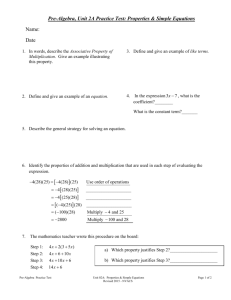
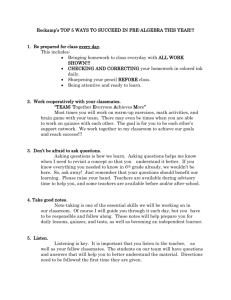
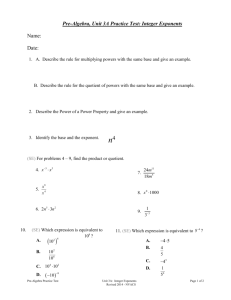
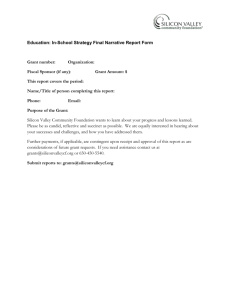
![Math 7_course_expectations_for_11_12[1]](http://s3.studylib.net/store/data/007346187_1-08d5f81a590e36509debb3f4d38734ae-300x300.png)
